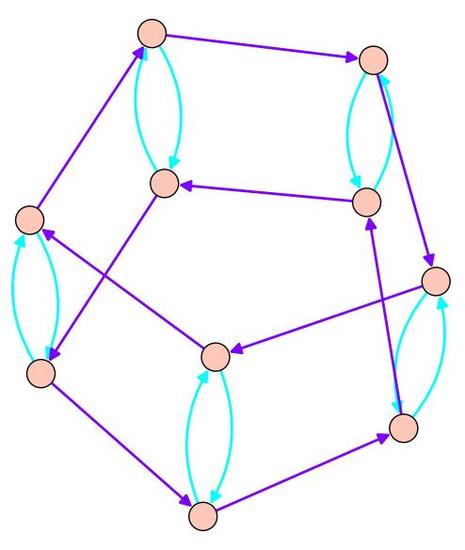3.4: Cosets and Lagrage's Theorem
( \newcommand{\kernel}{\mathrm{null}\,}\)
In this section, we'll prove Lagrange's Theorem, a very beautiful statement about the size of the subgroups of a finite group. But to do so,we'll need to learn about cosets.
Recall the Cayley graph for the dihedral group D5 as generated by a flip and a rotation. Notice that the darker blue arrows look like two different 'copies' of Z5 sitting inside of the dihedral group. Likewise, the light arrow loops look like five copies of Z2. Both Z5 and Z2 are subgroups of D5, generated by the rotation and flip respectively. These 'copies' of the subgroups that we see in the Cayley graph are examples of cosets.

Dihedral group Cayley graph, generated by a flip and rotation. The Cayley graph for the dihedral group with generators given by a flip and a rotation.
Let H be a subgroup of G, and H={h1,h2,h3,…}. Then for any choice of g∈G, the coset gH is the set {gh1,gh2,…}.
These are precisely the 'copies' of the subgroups that we saw in D5. The elements of D5 can all be written as firj with i∈{0,1} and j∈{0,1,…,4}. The rotation subgroup consists of the element R={e,r,r2,r3,r4}. Then R has two distinct cosets, R and fR={f,fr,fr2,fr3,fr4}. For any g we choose, gR is equal to one of these two cosets! Likewise, if we consider the subgroup F={e,f}, there are five distinct cosets given by riF, where i∈{0,1,2,3,4}. Notice that the cosets evenly divide up the group; this isn't an accident!
| Proposition 3.3.1 |
|---|
| Suppose that H is a subgroup of G. Let x,y∈G. Then either xH=yH or xH and yH have no elements in common. |
| Proof 3.3.2 |
|---|
| Suppose z∈xH and z∈yH. In particular, there exist h1,h2∈H such that z=xh1=yh2, and xh1h−12=y. We need to show that xH=yH, so take any h3∈H and consider yh3∈yH. Then yh3=xh1h−12h3∈xH, since h1h−12h3∈H. Thus, if xH and yH share any elements, then they are equal, and if they share no elements, they are tautologically disjoint! |
We'll need one more piece of notation.
The order of a group G, written |G|, is the number of elements in G.
So the order of R⊂D5 is |R|=5, and the order of the flip subgroup |F|=2. We can now prove Lagrange's Theorem!
| Theorem 3.3.4: Lagrange's Theorem |
|---|
| Let H be a subgroup of a finite group G. Then |H| divides |G|. |
| Proof 3.3.5: Lagrange's Theorem |
|---|
| Notice that every element of the group G shows up in some coset of H: since e∈H, we have g∈gH for every g. Therefore, every element of the group shows up in exactly one coset of H. Also notice that every coset of H has the same number of elements as H. (If the size of gH were less than |H|, there would be have to be two different elements h1,h2∈H with gh1=gh2. But cancelling the g's gives h1=h2, a contradiction.) Then the cosets of H break up G evenly into subsets of size |H|. Thus, |H| divides |G|, as desired. |
Find all of the subgroups of the permutation group S3 and the dihedral group D5.
Find a subgroup of the permutation group S4 with twelve elements. What are it's cosets?
Contributors and Attributions
- Tom Denton (Fields Institute/York University in Toronto)


